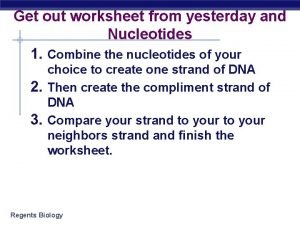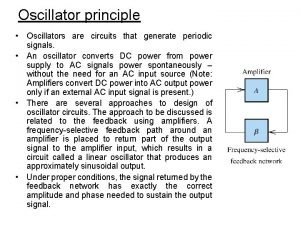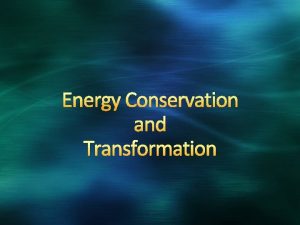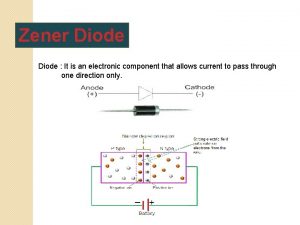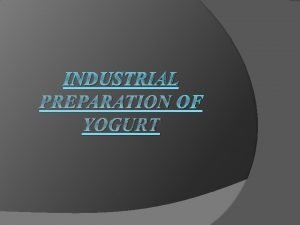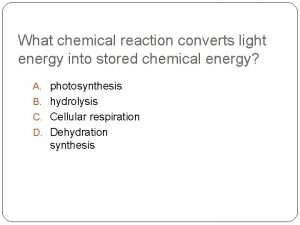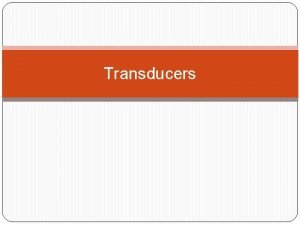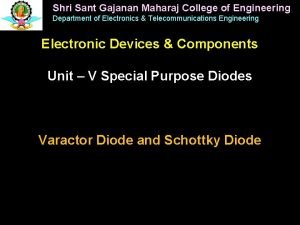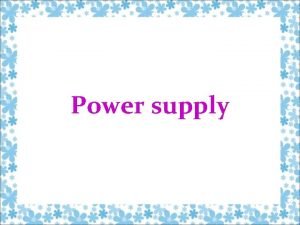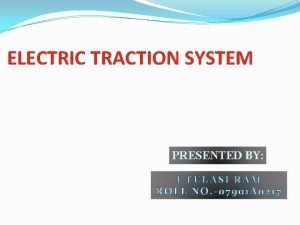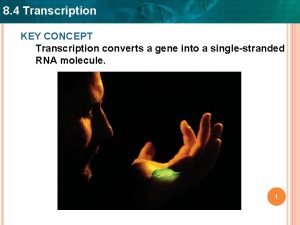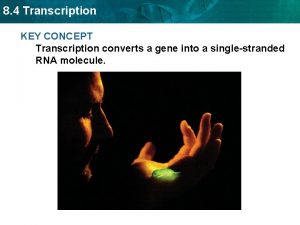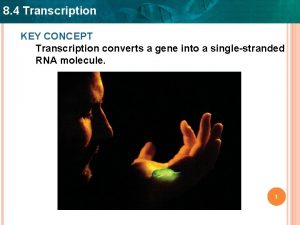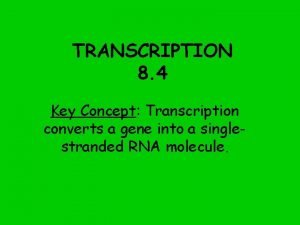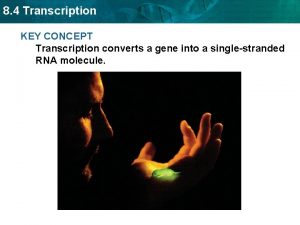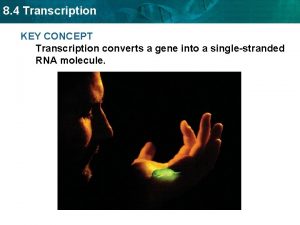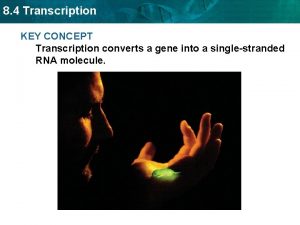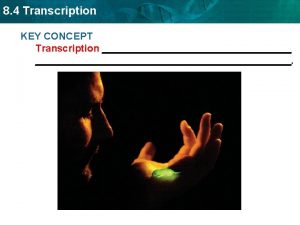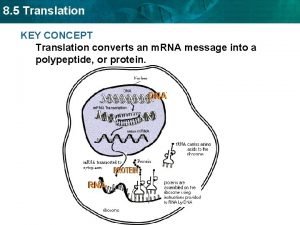8 4 Transcription KEY CONCEPT Transcription converts a













- Slides: 13

8. 4 Transcription KEY CONCEPT Transcription converts a section of DNA into a singlestranded RNA molecule.

8. 4 Transcription RNA carries DNA’s instructions. • The central dogma states that information flows in one direction from DNA to RNA to proteins.

8. 4 Transcription • The central dogma includes three processes. – Replication – Transcription replication – Translation transcription • RNA is a link between DNA and proteins. translation

8. 4 Transcription • RNA differs from DNA in three major ways. – RNA has a ribose sugar (not deoxyribose) – RNA has uracil base instead of thymine. – RNA is a single-stranded structure (DNA is double stranded)

8. 4 Transcription makes three types of RNA. • Transcription copies DNA to make a strand of RNA.

8. 4 Transcription • Transcription is catalyzed by RNA polymerase. – RNA polymerase and other proteins form a transcription complex. – The transcription complex recognizes the start of a gene and unwinds a segment of it. start site transcription complex nucleotides

8. 4 Transcription – Nucleotides pair with one strand of the DNA. – RNA polymerase bonds the nucleotides together. – The DNA helix winds again as the gene is transcribed. DNA RNA polymerase moves along the DNA

8. 4 Transcription – The RNA strand detaches from the DNA once the gene is transcribed. RNA

8. 4 Transcription • Transcription makes three types of RNA. – Messenger RNA (m. RNA) carries the message that will be translated to form a protein. – Ribosomal RNA (r. RNA) forms part of ribosomes where proteins are made. – Transfer RNA (t. RNA) brings amino acids from the cytoplasm to a ribosome.

8. 4 Transcription The transcription process is similar to replication. • Transcription and replication both involve complex enzymes and complementary base pairing. • The two processes have different end results. – Replication copies all the DNA; transcription copies one gene growing RNA strands a gene. – Replication makes one copy; DNA transcription can make many copies.

8. 4 Transcription The central dogma of molecular biology states that information flows in one direction from A. B. C. D. Nuclei to RNA to cytoplasm Ribosomes to proteins to DNA Genes to nuclei to ribosomes DNA to RNA to proteins

8. 4 Transcription Change the nucleotide sequence of RNA strand that would be complementary to the following DNA strand: GTAGTCA A. UATUAGA B. ACGACTG C. CAUCAGU D. CATCAGT

8. 4 Transcription The main function of t. RNA is to A. B. C. D. Carry a message that, when translated, forms proteins Form a portion of ribosomes, a cell’s protein factories String together complimentary RNA and DNA strands Bring amino acids from the cytoplasm to the ribosomes
 Transcription and translation practice worksheet answer key
Transcription and translation practice worksheet answer key Key concept summaries answer key
Key concept summaries answer key Key concept builder lesson 1 what are waves answer key
Key concept builder lesson 1 what are waves answer key An oscillator converts
An oscillator converts A hairdryer converts ____ energy into ____ energy.
A hairdryer converts ____ energy into ____ energy. Learning outcomes generator
Learning outcomes generator Pn junction diode, converts
Pn junction diode, converts Lactobacillus bulgaricus converts lactose to *
Lactobacillus bulgaricus converts lactose to * ________ converts light energy into chemical energy. *
________ converts light energy into chemical energy. * Introduction to transducers
Introduction to transducers Pn junction diode, converts
Pn junction diode, converts Line regulation
Line regulation Pn junction diode, converts
Pn junction diode, converts Arno converter converts
Arno converter converts
